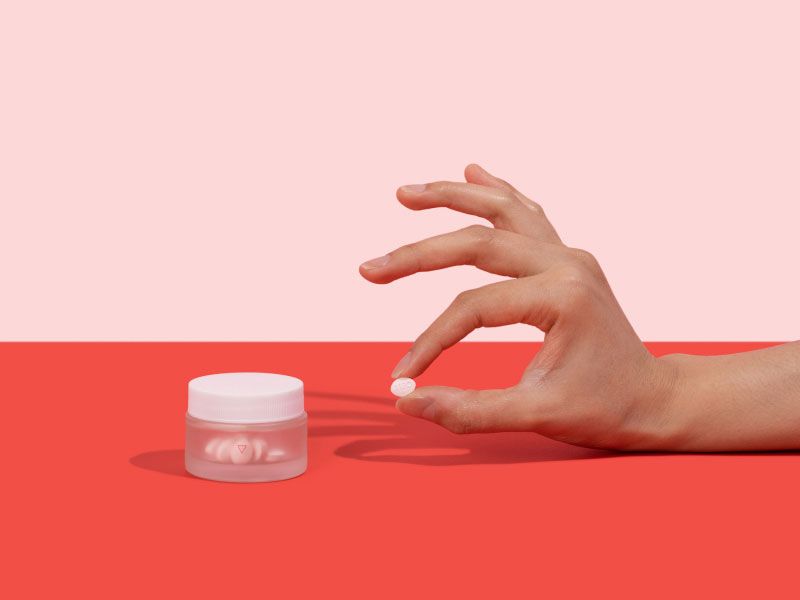
What Is Vaginitis?
Published on
June 12, 2025
Written by Kathleen Morrison
Medically Reviewed by Andrea Sleeth WHNP-BC, MSCP
Let’s get real—vaginitis is super common, but most people aren’t exactly shouting about it.
Honestly, most women will deal with some form of vaginitis in their lifetime, and it can show up as itching, burning, irritation, or discharge that feels...off. Basically, it’s your vagina’s way of waving a little flag and telling you something's up.
Vaginitis just means inflammation in the vagina, but there are a few different reasons it can happen.
Sometimes it’s caused by hormonal shifts like low estrogen levels. It could also be an infection, like a yeast infection or bacterial vaginosis. Other times, it might be a reaction to something like scented soaps, laundry detergent, tight clothes, or even your period products.
Your vaginal flora (aka your vagina’s natural ecosystem) is sensitive—and when something throws it off, vaginitis can follow.
Vaginitis 101
So... What is vaginitis? It's not some rare or taboo condition—it’s super common and nothing to be embarrassed about. If your vagina’s feeling itchy, irritated, or just not like herself, vaginitis might be what’s going on.
At its core, vaginitis is just an umbrella term for inflammation or irritation in your vaginal area. That can happen for lots of reasons—maybe your natural bacteria are out of balance (yeast or BV), maybe it’s an STI, or maybe your body didn’t deal well with a new soap or tight workout leggings.
No matter the cause, vaginitis symptoms often show up in familiar ways:
- Itching
- Burning
- Unusual discharge
- Discomfort during sex or when you pee
And you are definitely not alone. Around 75% of women will get a yeast infection at some point (yep, three out of four of us). Bacterial vaginosis? That’s actually the most common vaginal infection for women aged 15 to 44. Trichomoniasis and atrophic vaginitis are also part of the vaginitis fam, though they don’t get talked about as much.
Here's a little more about them (just so you know what's up).
Why Vaginitis happens in the first place
Let’s be real—your vagina is a powerhouse. But like any part of your body, it has its moods, and sometimes vaginitis is how it tells you something’s up.
There are a few common causes, and the more you know, the easier it is to spot changes and get the care you deserve.
You got thrown off balance
Your vagina has its own natural ecosystem—an entire community of good bacteria keeping things balanced and comfy.
But that balance can shift pretty easily. Douching, taking antibiotics, new sexual partners, or even just your period can shake things up and lead to something like BV.
TL;DR: your vaginal microbiome is sensitive.
Infections
Yeast infections and STIs like trichomoniasis are also common causes of vaginitis.
A yeast infection happens when candida grows a little too wild, often triggered by antibiotics, hormone level shifts, or stress on your immune system. Trich, on the other hand, is a super common (and curable!) STI caused by a parasite.
Products or friction
Vaginal irritation is another big one. Your vagina doesn’t need fancy soaps or floral-scented sprays—it’s got things handled.
But when it comes into contact with harsh products like scented body washes, detergents, spermicides, or even just damp underwear or tight leggings, things can get irritated. This kind of vaginitis is caused by contact, not infection.
Hormones
Estrogen plays a big role in keeping vaginal tissue healthy and hydrated. So when estrogen levels drop, like during menopause, postpartum, or while breastfeeding, it can change how things feel down there.
Dryness, itching, and irritation? Yep, that could be atrophic vaginitis. But you're not stuck with it, and relief is within reach for you, too.
What does Vaginitis feel like?
When something’s off down there, your body usually gives you a heads-up, and vaginitis is no exception. The symptoms can vary depending on what’s going on, but here are some of the most common signs your vagina might be trying to start a conversation.
Things to keep an eye (and nose) on
- Vaginal discharge that’s different from your usual (we’re talking color, texture, or amount)
- Vaginal itching, irritation, or that “something’s not right” feeling
- A new or stronger vaginal odor
- A burning sensation when you pee
- Pain or discomfort during sex
If any of that sounds familiar, you’re not alone—and it’s totally okay to seek answers.
What your discharge is telling you
Let’s break it down, because discharge is normal, helpful, and kind of like your vagina’s built-in notification system. A shift in how it looks or smells can help clue you in to what’s going on:
- Thick, white, and lumpy (like cottage cheese)? Probably a yeast infection.
- Thin, grayish-white, and fishy-smelling? That’s classic BV.
- Frothy, yellow-green, and strong-smelling? Might be trichomoniasis (aka trich).
- Not much going on at all? If you’re postmenopausal or breastfeeding, that dryness could be a sign of atrophic vaginitis.
When to reach out
While mild symptoms of vaginitis sometimes chill out on their own, it's important to get in touch with a healthcare professional and get the treatment you need (and deserve) if:
- You’ve never had vaginitis before and want to be sure
- Symptoms are intense or getting worse
- You’ve got a new sex partner (or more than one)
- You think it might be an STI
- You’ve tried home remedies or OTC treatments, and nothing’s working
- This keeps happening—and you're ready for it to stop
How is Vaginitis diagnosed?
If your vagina’s been sending out distress signals—like itching, burning, or discharge that feels off—it’s time to figure out what’s going on. And don’t worry, you don’t have to play guessing games.
Getting the right care starts with knowing what’s behind your symptoms. That’s where testing comes in—and you’ve got options.
At-home testing
Not into waiting rooms? We get it. Discreet at-home testing kits for vaginitis will give you the freedom to check in on your vaginal health from the comfort of your couch.
No stirrups. No awkward chats. Just clear answers delivered to your door—and then real relief, fast.
What happens if you see a provider?
If you do head to a clinic or doctor’s office, they’ll typically:
- Do a quick pelvic exam, where your provider will examine your vulva and vagina for signs of inflammation, vaginal discharge, or other symptoms
- Ask about your medical history, recent sex life, and any changes that could be affecting your vaginal balance
They may also collect a small sample of vaginal fluid to get a closer look at what’s going on.
A few common tests you might need
- Wet mount: A tiny sample of discharge is checked under a microscope to spot yeast, bacteria, or parasites
- pH test: Checks how acidic your vaginal environment is (imbalances here can offer big clues)
- Vaginal culture: A sample heads to the lab to see if anything’s growing that shouldn’t be
These tests are quick, typically painless, and incredibly helpful for figuring out exactly what kind of care you need.
How do you treat different types of Vaginitis?
Here's the thing, vaginitis is pretty straightforward to handle. Different types show up in different ways, and what you need depends on what’s causing the fuss down there. Usually, prescription meds for vaginitis are the way to go.
Here's how to handle some of the most common types of vaginitis:
Bacterial Vaginosis (BV)
Let’s start with BV, aka the most common vaginal infection for people with vaginas aged 15–44. It happens when the balance of bacteria in your vagina gets thrown off (think: too much of the wrong kind). If you’re noticing a fishy smell, thin gray-white discharge, or burning and itching, BV might be the culprit.
The fix? Prescription BV antibiotics are your BFF here—they'll get you back in balance fast.
Yeast Infections
Oh, vaginal yeast infections. If you’ve had one, you know the vibe: thick, white, cottage cheese-y discharge, intense itching, redness, and swelling that makes even leggings feel like too much.
It’s caused by an overgrowth of a fungus called Candida albicans, and it’s incredibly common—around 3 out of 4 people with vaginas will deal with it at some point.
Here, prescription antifungal meds are most likely to do the trick (and you don't need an awkward pharmacy run, either). An at-home vaginal microbiome screen can help you suss out what will and won’t work on the specific strain of Candida you’re dealing with.
Trichomoniasis
This one’s a sexually transmitted infection (STI) caused by a tiny parasite, and while “parasite” might sound scary, trich is actually super common and also curable with prescription oral antibiotics for trich, usually either metronidazole or tinidazole.
If you’ve got frothy yellow-green discharge, a strong odor, itching, or discomfort during sex or peeing, it could be trichomoniasis. And if you’re not sure? Discreet at-home STD testing and treatment can help you feel more confident.
Irritant Vaginitis
Sometimes your vagina is just not feeling that new body wash or those super tight yoga pants. Irritant (or noninfectious) vaginitis happens when something external causes your vaginal area to get irritated—like harsh soaps, scented products, spermicides, or damp clothing.
The symptoms might feel just like other kinds of vaginitis: itching, burning, maybe some discharge.
If your vagina is throwing a fit, a little detective work (and cutting out harsh products) can go a long way.
Atrophic Vaginitis
This one usually shows up during or after menopause, when estrogen levels drop and your vaginal tissue starts feeling thinner, drier, and more sensitive.
That might mean dryness, itching, or pain during sex, and while it’s common, that doesn’t mean you have to just live with it.
Low-dose estrogen creams can help restore some of your moisture and comfort.
Wisp treatment options are available only after consultation with a licensed medical professional. You should consult with your healthcare provider before starting a new supplement or treatment regimen. Individual results may vary.
How can you support your body through it?
Besides meds, a few simple self-care moves can soothe your symptoms and keep your vagina happy while you you get your vaginitis treated:
- Keep your genital area clean and dry—skip the scented soaps, douches, and tight clothes that can stir up trouble.
- OTC supplements like boric acid and probiotics can help keep your balance in check and support your downstairs health.
- A cold compress on the vulva can be surprisingly calming when itching or burning flares up.
- Over-the-counter pain relievers like ibuprofen can help ease discomfort.
- Take a break from sex until things settle down—your vagina will thank you.
Keep in mind that self-treating with the wrong kinds of meds could actually make your symptoms worse and even lead to other complications nobody needs. Trust the experts on this.
How to keep your vagina happy (long-term)
Okay, so even if you're doing all the “right” things, there's no guarantee you can prevent vaginitis.
But there are definitely some simple habits that can help keep your vagina balanced and comfy.
Everyday hygiene things
- Wipe front to back after using the bathroom—yes, it really does make a difference
- Change out of wet or sweaty clothes as soon as you can. Nobody likes sitting around in soggy underwear
- Avoid douching, scented hygiene products, and those vaginal sprays (you don't need them and they're not worth the trouble)
- Stick to breathable cotton underwear whenever you can—it lets your skin breathe and keeps things happy down there
- Swap out pads and tampons regularly during your period
Lifestyle and sex tips
- Use condoms—it’s one of the easiest ways to keep things clean and clear during sexual contact so you can avoid any issues making an unwanted comeback
- Keep your sexual partners to a number that feels right and safe for you
- If you smoke, think about cutting back
- Eat well-balanced meals with less sugar to keep your body feeling great inside and out
- Stress is a sneaky little troublemaker, so find ways to chill and take care of your mental health
- Don’t skip your regular check-ins with your healthcare provider
Kick the itching to the curb
Vaginitis is very common—and very treatable. Most folks with vaginas will deal with it at some point, so you’re definitely not alone.
The good news? Knowing the signs, causes, and what’s available to help means you’re already one step ahead in taking care of yourself.
If things feel off for a while or get intense, don’t hesitate to chat with a healthcare provider—you deserve answers that fit your unique body and lifestyle.
That’s where Wisp comes in. We’re here with trusted prescription options, easy at-home testing, and discreet online consultations—all designed to make getting care simple, comfortable, and on your terms.
Frequently Asked Questions (FAQ):
How do you get vaginitis?
Vaginitis can be caused by a lot of things: an imbalance of normal vaginal bacteria, yeast infections, certain sexually transmitted infections like trichomoniasis, or even irritation from products like soaps or douches. Basically, it’s your body’s way of waving a flag that something’s up down there.
What does vaginitis smell like?
Different causes can bring different smells. Bacterial vaginosis often has a fishy odor, while yeast infections have a subtle, bread-like smell or sometimes none at all. Trichomoniasis can cause a more noticeable, unpleasant odor. Remember, your vagina has its own natural smell, so changes can be a helpful clue.
Is vaginitis the same as BV?
Not quite. Vaginitis is the general name for inflammation or irritation in the vagina. Bacterial vaginosis, or BV, is just one kind of vaginitis, when certain bacteria grow more than they should. So, BV is a type of vaginitis, but vaginitis isn’t always BV.
What is the main cause of a vaginal infection?
There are a few usual suspects: too much of certain bacteria, yeast growing beyond its usual limits, some sexually transmitted infections, or irritation from soaps, douches, or other products. Your body’s trying to tell you it needs a little extra care.
This blog post is for informational and educational purposes only and should not be taken as professional advice. Always consult with a qualified professional before making any decisions based on the information provided here.

BV Antibiotics (Tablets or Gel)
Starting at $15
Request topical or oral prescription antibiotics to treat bacterial vaginosis.

Diflucan, Generic Fluconazole (Yeast Antifungals)
Starting at $45
Prescription antifungals used to treat vaginal yeast infections

Estradiol Vaginal Cream
Starting at $20
A hormonal cream that soothes vaginal dryness caused by menopause, or during postpartum, especially with breastfeeding.


